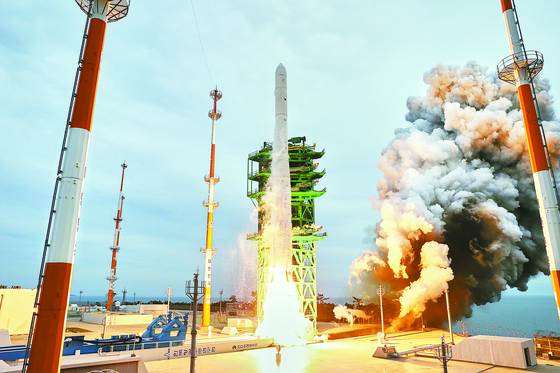Tackling challenges of the final frontier

Chang Duk-jin
The author is a professor of sociology at Seoul National University and a steering committee member of the JoongAng Ilbo’s Reset Korea Campaign.
With the successful launch of the homegrown Nuri-3 rocket in May, Korea is said to have joined the Group of Seven space powers. The remarkable achievement certainly deserves a big praise for all the participants, including the devoted scientists and engineers at the Korea Aerospace Research Institute (KARI).
For most Koreans, however, space still remains an unknown world. The memories they have are the intense moment of the Apollo 11 landing on the moon in 1969, followed by the successful launches of Korea’s first satellite Uribyeol-1 in 1992, Arirang-1 satellite in 1999, and its first carrier rocket Naro-1 in 2013, as well as the half-baked success of Korea’s first domestically developed Nuri-2 rocket in 2022 and finally the successful lifting of the Nuri-3 rocket last month.
Many parents who brought their kids to the spots near the Naro Space Center in South Jeolla last month to show them the thrilling moment of the rocket blasting off from the ground may wish their children to join humanity’s uninterrupted journey to the unknown universe someday.
Apollo 11, a legacy of the Cold War
But reality is more stark than romantic. The Apollo 11 moon landing itself was a byproduct of the heated regime race during the Cold War. In reaction to the Soviet Union’s launch of the first Earth-orbiting artificial satellite Sputnik 1, U.S. president John F. Kennedy embarked on the Apollo program to send humans to the moon within 10 years, outpaced the Soviets in the race, and finally succeeded in leaving human footprints on the surface of the moon in 1969.
According to the U.S. National Aeronautics and Space Administration (NASA), more than 8,000 manmade objects are floating in orbit today and about 3,000 of them are functioning. So far, the U.S. has launched the biggest number of satellites (about 6,200) followed by Russia (1,500), China and Britain (600 each), Japan (200), India, France, Germany and Canada (100 each), and Korea and Australia (over 30 each). More than 80 countries have shot up at least one satellite.
Gulf War, the first space war for humanity
Space war has become reality already. The 1991 Gulf War was recorded as mankind’s first space war. Though battles did not take place in space, U.S. forces could precisely detect the locations of the enemy thanks to the global positioning system (GPS) and win the war with speed and accuracy the Iraqi forces could not imagine. The navigation system of cars originated with the GPS used in the Gulf War.
Since the Gulf War, space has become a most important strategic and military goal. Since the establishment of a space development department in the U.S. Air Force in 1954 — a year before the start of the Vietnam War — the space department has been involved in all U.S. military interventions. In 2019, the Pentagon officially founded the Space Force, where 8,600 people are currently serving. After creating the People’s Liberation Army Strategic Support Force in 2015, China is bracing for war in the space, cyber, political and electronic realms.
Korea is no exception. After founding the Space Operation Battalion last December, the country is preparing for a space war through a joint space drill with its ally. The successful launch last month of the domestically developed space launch vehicle to put satellites into orbit carries great significance for national security, as it means the country doesn’t have to rely on other countries such as the U.S. to find signs of suspicious movements in the country across the border.
Support from space will play a key role in determining victory or defeat in all future wars, which is why major space powers are fiercely racing to develop anti-satellite missiles or other means for cyberattacks on satellites.
The accelerating U.S.-China space contest
The fiercest battle over space is being waged between America and China. China still has a long way to go, but the country uses massive budget and manpower to outpace the U.S. in space. Korea has become the seventh strongest space power, but lags far behind China. Only India strives to overtake China in the Asian theater.
Despite enormous repercussions of conflict over space, international rules on the use of space are stuck in the 1967 Outer Space Treaty. But the treaty cannot prevent countries from firing missiles to satellites in space, as it only bans placing in orbits around the earth “any objects carrying nuclear weapons or any other kinds of weapons of mass destruction.” Given the nature of arms race, if a certain country attacks satellites of the enemy or weaponizes its own satellites, other countries will take the same action, pushing space into a “semi-state of war.”
The U.S. and major space powers in the West have joined in the Artemis Accords — a series of agreements aimed at establishing a governing framework for exploring and mining the Moon. But China, Russia and India have not signed it yet. As the signing of the accord represents a concession to the U.S. space leadership, the likelihood of Beijing signing the accord is nearly zero.
Considering the accelerated contest over technology hegemony between the U.S and China, even space could split between a U.S.-led bloc and China-led bloc. Korea will have to tackle the question pretty soon with the successful launch of its own satellites into orbit.
Space resource development is key
Space exploration will have an immense impact on the economy in the mid- to-long term. Not to mention the trickledown effect from space industry, such as job creation, it tremendously helps to develop natural resources. If we can bring home helium-3 — a coveted resource for major powers — from the moon, it can be used for nuclear fusion by replacing tritium, the controversial radioisotope of the gas hydrogen contained in the treated water from the crippled Fukushima nuclear plant. If we can use helium-3 to generate nuclear energy, it can help achieve genuinely clean nuclear power.
In the ongoing Artemis program which NASA started in 2017, countries such as Europe, Japan, Australia, Canada, Italia, Luxemburg, the UK, the UAE, Ukraine and New Zealand participate. Korea took part in the project in May 2021. Japan, a pivotal partner of the program, already passed a related bill to utilize space resources. Space development led by the private sector, including SpaceX launched by Elon Musk and Blue Origin founded by Jeff Bezos, is the most outstanding trend in the field today.
Private companies’ participation is lacking
In the latest launch of the Nuri-3 rocket, a number of local companies such as the Korea Aerospace Industries and Hanwha Aerospace took part, but private companies’ participation in the market is not as aggressive as other advanced space powers, not to mention their relatively low profitability. The massive trickledown effect from space industry demands thorough preparations from stakeholders.
Advancement into space calls for more than curiosity about the unknown, as it is a humongous project that requires a well-choreographed strategy to address many challenges such as regime competition for cutting-edge technology, security, war, rearrangement of the military, international politics, expansion of technology blocs, global energy and environment crises, the emergence of space enterprises and revamping of the global economy.
On the government side, the mission demands a methodical collaboration among the Ministry of Economy and Finance, the Ministry of Science and ICT, the Ministry of National Defense, the Ministry of Foreign Affairs, the Ministry of Education, the Ministry of Trade, Industry and Energy, the Ministry of SMEs and Startups, and the Ministry of Environment.
Korea could become the most successful model for economic development in the industrial age after World War II thanks to the farsighted investment unimaginable at the time. As the industrial age recedes, the new era of artificial intelligence and space exploration has opened. We must brace for a totally new leap forward now.
Policy coordination and macroscopic insight are needed
In that sense, the government must pay special attention to the statement by engineers of KARI after the successful launch of the Nuri-3 rocket last month. They came up with seven demands, but they can converge into the need for the government to set a national-level strategy to integrate diplomacy, security, defense and industry for space development.
A comparative analysis of OECD member countries shows Korea needs policy coordination and long-term sustainability more than anything else. The demands by the engineers at KARI are actually similar to the past ones from nearly all areas of government policy.
But if we lose in the battle for space exploration, we may never be able to have the upper hand in challenging the final frontier. I hope the government takes a farsighted approach, mixes it with all the expertise in the field, and reaches a harmonious conclusion for the country’s future.
Translation by the Korea JoongAng Daily staff.











with the Korea JoongAng Daily
To write comments, please log in to one of the accounts.
Standards Board Policy (0/250자)